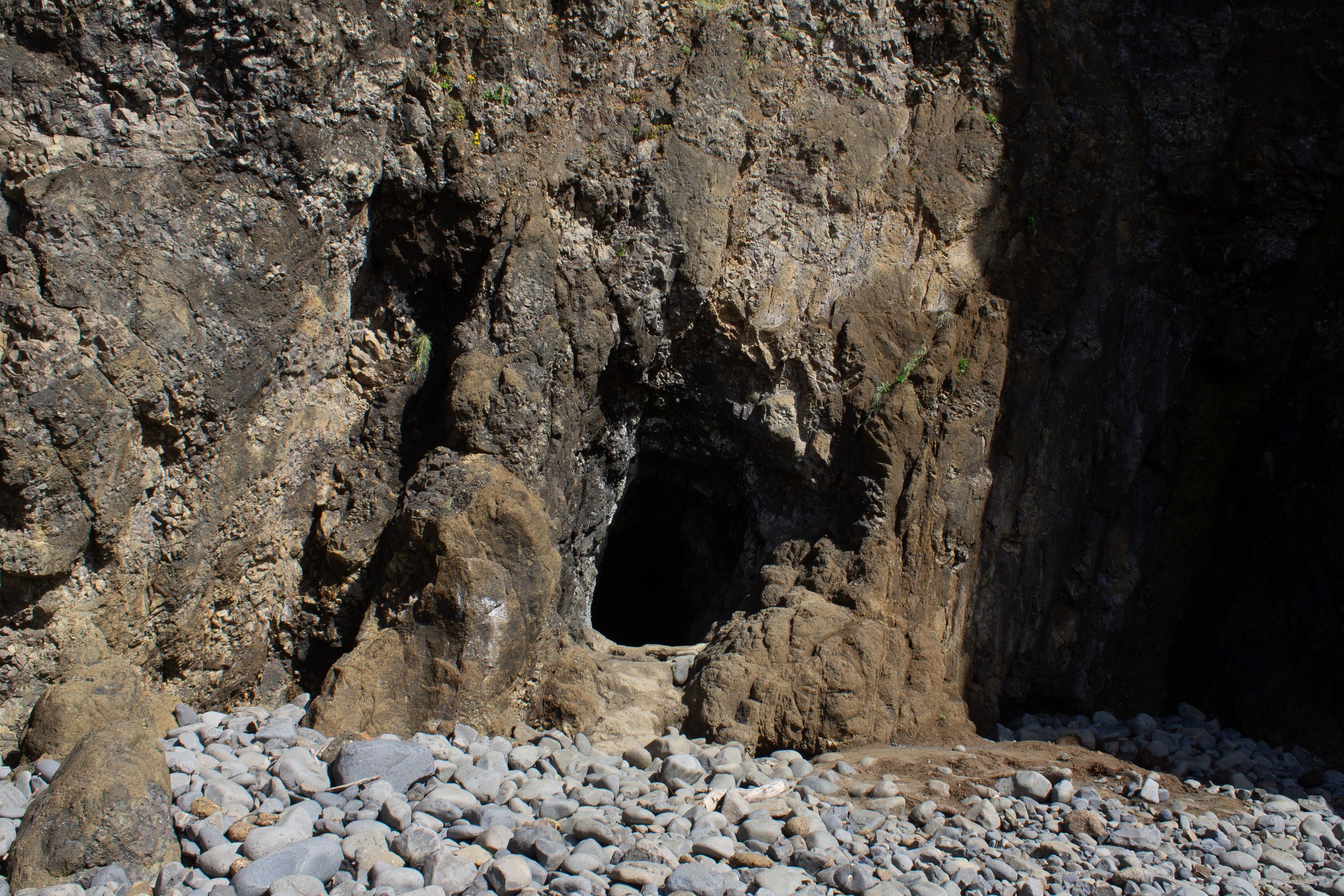The Mysterious Oregon Coast Tunnel
At first glance, the beach in the small town of Oceanside, Oregon, looks like many others on the Pacific Coast. At its northern end, a large headland looms. Looking south, a ribbon of sand stretches out toward Cape Lookout, a distant jutting peninsula. Inland, the town of Oceanside sits unobtrusively on hills covered with salal and conifers. Although scenic and peaceful, it doesn’t necessarily stand out among the Oregon Coast’s many stunning beaches. But then you see the tunnel, and you’ll remember it forever.
Oceanside Beach
Know before you go
Oceanside Beach has a free public parking lot. You don’t need a pass or permit to park. Look for street parking in Oceanside if the lot is full (it usually isn’t).
Restrooms are next to the public parking.
Dogs are welcome at Oceanside Beach. Taking a dog to Tunnel Beach would be difficult but potentially doable if you’re determined.
Most kids go through the tunnel just fine. Older kids will have no trouble. Younger ones may need to be carried.
To reach Tunnel Beach, you’ll navigate uneven terrain and dimly lit spaces. Wear shoes while you’re in the tunnel.
Bring a light to help you walk through the tunnel. A cell phone light is usually enough. A flashlight is better.
Oceanside is a small town but has a few restaurants.
Maxwell Point and its tunnel
How to find the Oceanside Tunnel and Tunnel Beach
This one’s easy. From the parking lot, walk down a short ramp to Oceanside Beach. You might want to spend some time here before moving on. This picturesque beach is off the beaten path and gets fewer visitors than many on the Oregon Coast. At the north end of Oceanside Beach, you’ll see a large headland called Maxwell Point. Walk towards it. The tunnel entrance is at its base.
Tunnel entrance
Once you get close to the tunnel, you’ll walk over some rocks to reach its entrance. A sign warns you about falling rocks, but don’t worry too much about it. The tunnel is not known for being dangerous. In the unlikely event that a rockslide blocked your return journey, you could walk around Maxwell Point at low tide.
Inside the tunnel, you’ll walk 90 feet through the underground passage to reach the other side of the headland. It’s never totally dark, but you’ll want to have a light source with you. On a sunny day, my phone’s flashlight was all I needed. On a gloomy one, I would have liked a little more light.
Inside the tunnel
Rocks in the tunnel make the journey more difficult. You’ll need to watch your footing as you go. The last time I visited, rocks were the only obstacle. Another time, driftwood and standing water added an extra challenge. High waves can carry driftwood into the tunnel under the right conditions. Check a tide table before you go. You don’t need to time your visit with low tide to see Tunnel Beach, but skip it during high tide events like the king tides and storms.
When you exit, you’ll be at Tunnel Beach
About the Oceanside Tunnel
Oceanside’s tunnel, officially called the Maxwell Point Tunnel, is the relic of a former tourist attraction. The Rosenburg family built it in 1926 to allow guests staying at their resort to safely access the neighboring beach, now called Tunnel Beach. Before the tunnel’s construction, Maxwell Point was a major obstacle that made this journey difficult at best. Today, the resort is gone but its tunnel remains.
Sea stacks off the shore of Tunnel Beach
The tunnel is 90 feet long and passes 191 feet below the top of Maxwell Point. It begins as concrete and transitions to the headland’s natural rock. Rockslides have blocked access to the tunnel a few times since its construction. The most significant one was in 1979, which closed off the tunnel until the 1990s.
Tunnel access from Tunnel Beach
When the Rosenburg family built the tunnel, they also made a walkway that connected Tunnel Beach and the next beach to the north, Lost Boy Beach. This walkway no longer exists and I’d suggest ending your journey at Tunnel Beach for safety. From the parking lot, it’s about a 0.8-mile out-and-back trek to the north end of Tunnel Beach.
Tunnel Beach
After stumbling over rocks and driftwood in the tunnel, you’ll have a huge reward when you emerge at Tunnel Beach. Even though it’s rarely crowded, I can’t call it a secret. There have always been a handful of other visitors when I’ve gone. Most of the people you see here will be bent over double on the hunt for treasures like agates, jasper, and sea glass.
Tunnel Beach
Tunnel Beach is one of the best rockhounding spots on the Oregon Coast. Even I found a bit of sea glass there, and I was focused on getting photos without running afoul of incoming waves. For the best chance of finding something good, go at a falling tide. Scan the ground as you follow the receding water. Have a spotter with you to keep an eye on the ocean in case of sneaker waves. Winter and spring are the best seasons for rockhounding since winter storms churn up sand.
Even if you’re not interested in rocks, Tunnel Beach is worth a visit. Headlands to the north and south form a little cove that feels cut off from the world. Offshore sea stacks are great places to look for seabirds. At low tide, you can find some tidepools with critters like barnacles, anemones, and sea stars.
Black oystercatchers perch on the sea stacks near Tunnel Beach
Beyond Tunnel Beach
For the sake of completeness, there is another beach north of Tunnel Beach called Lost Boy Beach. Around several times a year, you might be able to reach it at a very, very low tide. Think around -2 or below on a tide table, a rarity on the Oregon Coast. The day should also be calm and you would need to return to Tunnel Beach before the tide comes back in.
A headland at the north end of Tunnel Beach blocks access to Lost Boy Beach
I have not been to Lost Boy Beach and I don’t have plans to go. I’ve seen it from a distance looking out from the viewpoints at Cape Meares. The beach looks pretty and has the same rugged loveliness as the neighboring beaches but without any particularly unique features. In other words, I’d say the game isn’t worth the candle on this one.
For a cool and secluded beach that you can explore safely, drive north for a few minutes and take the makeshift staircase down to Short Beach. This uncrowded beach has excellent rockhounding potential, a manmade waterfall, and a weird rocky blob out in the water.
Short Beach
Or, take a 1.8-mile out-and-back trail through an old-growth forest to find a lesser-known beach at the north end of Cape Meares State Viewpoint.
Cape Meares Beach
Getting there
To reach Oceanside from Portland, take Highway 26 W past Hillsboro, then make a slight left onto OR-6 W. Continue on OR-6 W for 50 miles. When you reach Tillamook, make a left onto Main St and continue on OR-131 until you arrive at Oceanside. You’ll see the public parking lot next to the beach. The drive from Portland takes about 1 hour 40 minutes.
Explore nearby
Find the best things to do at Cape Meares State Scenic Viewpoint.
Find another great hidden gem beach at Sitka Sedge State Natural Area.
Visit the Neskowin Ghost Forest.


















